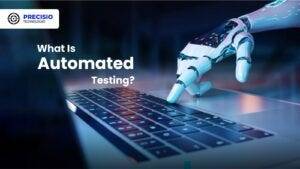#Software Testing Automation
Explore tagged Tumblr posts
Text
5 things to know about AI-driven software testing

In the modern software development landscape, reliance on technology is increasing for efficient and effective software development. The key aspect of software development is software testing, which ensures the applications and systems work as intended. Integration of AI in the software testing process is prevalent and represents a paradigm shift in quality assurance, offering numerous benefits over traditional methods.
In a study titled “Future of Quality Assurance 2023” by LambdaTest, 1,615 software testing professionals from 70 countries illuminate the software testing practices in 2023, including that 78% have already adopted AI.
The importance of AI in testing lies in its ability to streamline processes, reduce human intervention, and contribute to a faster, more reliable software development cycle. Let’s understand AI in test automation and explore the truths about automated software testing.
Understanding AI in test automation
Artificial intelligence (AI) techniques and algorithms enhance and optimize the testing process during the software development lifecycle. The purpose of using AI in software testing is not to automate tedious tasks but;
Automate repetitive tasks
Predict and solve complex defects such as code changes, historical defect data, and other relevant factors to understand potential issues and areas of the software.
Generate adaptive test cases based on requirements, specifications, and historical data.
Log analysis analyzes log files and other system data to identify patterns and issues.
Use behavior simulation to imitate user interactions to uncover usability issues, performance bottlenecks, and other problems.
It ensures the improvement of overall software quality and speeds up the testing process. Using various techniques such as machine learning, natural language processing, computer vision, and deep learning helps to make efficient decisions, making them faster, more accurate, and cost-effective. It aims to improve the effectiveness of the testing process and deliver higher-quality software products to end-users.
Suggested: The role of AI and ML in test automation evolution
Now, let’s explore the truth about AI in software test automation.
1. AI in software testing for better software quality
Undoubtedly, AI can enhance software quality, analyze data, and identify patterns. AI-driven testing tools can detect defects, vulnerabilities, and performance that can be challenging with manual testing. By automating repetitive tasks, AI contributes to a robust and reliable software product and delivers software faster.
These innovative tools enable swift execution of test cases by giving quick feedback on code changes. It not only reduces time-to-market but ensures new features do not consist of unforeseen bugs in the existing codebase.
2. Minimal maintenance for visual updates and redesigns with AI testing
The purpose of functional UI is to validate the functionality of an application’s user interface. However, functional UI testing can be challenging for web and mobile applications particularly when the testing framework is dependent on the DOM model. Tests utilizing DOM-based element selectors are prone to failure as UI structure and behavior evolve with updates.
AI with computer vision provides a revolutionary capability to perceive and test the functionalities displayed on the screen. Through image-based analysis, AI can identify elements on an application screen and how it is implemented. This eliminates the necessity for DOM-based analysis, minimizing the need for extensive test script maintenance when UI designs change.
3. One-size-fits-all solution is a myth
The adoption of AI test automation solutions is essential for diverse project success. The need for each software project may vary according to its complexity, technological stacks, and requirements. AI-based testing solutions might work well for one project but may not be suitable for another. Therefore, decision-makers, before opting for the solution, must evaluate their requirements and then leverage AI rather than expecting it as a universal solution.
For AI application testing to be effective, specify your project requirements and customize accordingly. The customization includes training of an artificial intelligence model based on content, adjusting the algorithms for a better understanding of the application’s requirement, and seamlessly integrating with the existing tools and project workflow.
4. Increase test coverage and test speed level with AI
Traditional test automation involves manual test case creation for each new feature and application that may take weeks or months to complete. Also, it might create a high level of risk like functionality failure and UI accessibility. As software complexity is rising faster, performing the testing powered by AI has become necessary to validate the quality of the software product right from the engineering team’s ability to design and test script writing.
5. AI-driven testing will not replace human testers
The introduction of AI in software testing raised a common misconception of replacing human testers and diminishing the value of their expertise. The fear emerged from AI’s ability to automate repetitive tasks, speed up the process, and analyze the vast data sets with unprecedented efficiency.
AI-driven testing tools do not replace testers, but they augment their capabilities. It automates the repetitive tasks and frees them to focus on more intricate work, allowing them to create testing scenarios that demand human intuition, understanding of user behavior, and strategic thinking. Artificial intelligence can execute thousands of test cases and deliver feedback at the same time. It still relies on human testers to interpret results, make strategic decisions, and provide the necessary understanding of complex test scenarios.
AI-powered tools for software testing
Healenium
Healenium is a software testing platform that utilizes AI and ML algorithms to optimize and automate the testing process. Some of its key benefits are:
Minimizes maintenance time of test automation code
Improves CI pipeline stability, reducing the testing stage failures
Enhances efficiency in your test automation
Suggested: Explore test automation with Healenium
Report portal
ReportPortal is an open-source, AI-powered test automation reporting platform designed to enhance the visibility and efficiency of software testing processes. Some of its benefits are as follows:
Automated decision-making
Real-time analytics
Test results visualization
Transparency of test failure reasons
Tracking key metrics and KPI
Testrigor
An executable specification engine designed to allow anyone on your team to build, maintain, and understand tests created and executed in plain English.
Maximize productivity
Build test automation 50 times faster than its competitors
Quickly achieve test coverage with minimal maintenance
Test case generator
It is an in-house AI tool created by an expert QA team of Softweb Solutions. This integrates with project management platforms efficiently. Some of its benefits include:
Improved quality assurance
Faster turnaround times
Reduced manual efforts
Scalability
Conclusion
Various industries have started using AI in test automation. Companies are leveraging AI technologies to streamline their testing processes, reduce manual efforts, and improve the speed and accuracy of test execution. It enables testers, developers, and software professionals to cope with the challenges that were once thought to be impossible. Do you want to improve your software testing process? Elevate your software quality with our AI-powered QA testing services. Contact our experts for automated testing as a service.
Originally published at softwebsolutions on June 17, 2024.
#ai software testing#ai test automation#ai testing services#ai for software testing#software testing automation
1 note
·
View note
Text
Enhancing Software Testing with AI: A Game-Changer for the Future

The Significance of QA in Software Development
Introduction:
In the ever-evolving world of software development, ensuring that applications and systems run seamlessly is critical. Artificial Intelligence (AI) has emerged as a transformative force, revolutionizing quality assurance (QA) automation by improving efficiency, accuracy, and reliability. In this article, we'll explore how companies are leveraging AI in QA automation and delve into the latest technological trends that are reshaping the landscape.
The Emergence of AI in QA Automation
Why AI in QA Automation?
AI in Quality Assurance (QA) Automation offers several compelling advantages, making it a valuable addition to the software development process. Here are the key reasons or advantages for integrating AI into QA Automation
• Enhanced Efficiency : AI streamlines QA processes, reducing the need for manual intervention and accelerating testing.
• Improved Accuracy : AI algorithms are proficient at identifying potential issues, ensuring comprehensive test coverage.
• Cost Savings : By predicting vulnerabilities and addressing them proactively, AI saves both time and resources.
• Real-time Feedback : Integration with Continuous Integration and Continuous Testing (CI/CT) allows AI to provide rapid, real-time feedback.
• Simplified Communication : Natural Language Processing (NLP) algorithms simplify test documentation and facilitate effective communication among team members.
How is AI technology integrated into the QA process?
AI technology is integrated into the quality assurance (QA) process to enhance its efficiency, accuracy, and overall effectiveness. It serves several specific functionalities within QA, addressing various aspects of testing and validation. Here's how AI is integrated and the specific functionalities it serves in the QA process.
Specific functionalities it serves:
1. AI-Driven Test Case Generation: Algorithm Proficiency : AI algorithms have evolved to become proficient at generating test cases. They do this by analyzing the application's code and comprehending its functionality.
Reducing Manual Effort : The reliance on manual test case creation is reduced, as AI can automatically generate test cases.
Comprehensive Test Coverage : AI identifies potential issues within the application, which helps in achieving comprehensive test coverage, ensuring that various aspects of the software are thoroughly tested.
2. Predictive Analytics for Bug Detection: Machine Learning Models : Predictive analytics in AI relies on machine learning models to identify vulnerabilities, bugs, and areas of concern within the codebase.
Proactive Approach : This proactive approach allows companies to address potential issues before they escalate into major problems, ultimately saving time and resources.
3. Continuous Integration and Continuous Testing (CI/CT): AI Integration : Integrating AI into CI/CT pipelines is a game-changer for software development.
Automated Testing : AI algorithms can execute tests in parallel, ensuring rapid feedback and real-time identification of bugs.
Accelerated Development : By automating testing at each development stage, CI/CT with AI accelerates the entire software development lifecycle.
4. Natural Language Processing (NLP) for Test Documentation: Extracting Insights : NLP algorithms extract valuable insights from test plans and logs, making it easier to understand and interpret test results.
Improved Communication : This simplifies communication among team members and stakeholders, enabling them to pinpoint issues more efficiently.
5. AI-Driven Test Maintenance: Automated Updates : AI-based tools detect changes in the application's functionality and automatically update test scripts.
Reducing Manual Work : This automation significantly reduces the burden of maintaining test suites, which is often a time-consuming task in QA.
6. Automated Visual Testing: Human Vision Simulation : AI in automated visual testing simulates human vision, allowing it to identify visual anomalies in applications.
Enhanced User Experience : This ensures a polished user experience by automatically detecting issues like UI glitches or layout problems.
7. Test Data Generation: Realistic Data Sets : AI algorithms can generate diverse and realistic test data that mimics real-world scenarios.
Enhancing Accuracy : This enhances the accuracy of test results as the test data closely resembles what the application is likely to encounter in the real world.
8. Virtual QA Assistants: Chatbots and Virtual Assistants : Equipped with AI, chatbots and virtual assistants can answer common QA-related queries, guide team members, and even execute simple testing tasks.
Accessibility : This makes QA more accessible to all stakeholders, regardless of their technical background, as they can interact with these virtual assistants.
9. AI-Enhanced Performance Testing: Real-World Simulation : By doing so, they can identify performance bottlenecks and optimize application performance, ensuring that the software can handle real-world usage effectively.
Identifying Bottlenecks : By automating testing at each development stage, CI/CT with AI accelerates the entire software development lifecycle.
In conclusion, AI in QA automation is revolutionizing the software testing process by enhancing efficiency, accuracy, and overall software quality. Each of these AI-driven components contributes to a more streamlined and effective QA process, ultimately leading to better software and improved user experiences.
Emerging Tech Trends in AI QA Automation
• AI in Security Testing: With the growing threat of cyberattacks, AI is used to identify vulnerabilities and weaknesses in software security.
• AI in Mobile App Testing: As mobile applications gain prominence; AI ensures their functionality and performance across various devices and operating systems.
• AI in Cloud-Based Testing: With companies shifting to cloud-based infrastructure, AI aids in testing the scalability, reliability, and compatibility of cloud-deployed applications.
• AI in Robotic Process Automation (RPA) Testing: RPA is integral to business processes, and AI validates the functionality of bots and automated workflows.
Disadvantages of AI in QA Automation
While AI in QA automation offers numerous advantages, there are also certain disadvantages and challenges associated with its implementation.
Here are some of the disadvantages of AI in QA automation:
1. Initial Implementation Challenges: • Setting up AI-driven QA processes can be complex and require significant initial investments in terms of infrastructure, tools, and training.
• Organizations may face resistance from team members who are unfamiliar with AI technology and may require time to adapt to the new workflows.
2. Dependency on Data Quality • AI in QA heavily relies on data for training machine learning models and making predictions. If the data used is of poor quality, biased, or unrepresentative, it can lead to inaccurate results.
• Ensuring high-quality, relevant, and up-to-date training data is essential for the success of AI-driven QA.
3. Ethical and Privacy Concerns: • AI algorithms may inadvertently perpetuate biases present in the training data, which can lead to unfair or discriminatory outcomes in testing.
• Data privacy and security concerns arise when sensitive information is used for testing, and it must be handled with care to avoid breaches or compliance issues.
4. Limited Human Judgment and Creativity 5. Maintenance and Updates 6. False Positives and Negatives 7. Integration Challenges 8. Costs of AI Implementation 9. Skill Gap 10. Overreliance on AI
It's essential for organizations to carefully weigh the advantages and disadvantages of AI in QA automation and implement strategies to mitigate potential drawbacks. A well-balanced approach that combines AI's strengths with human expertise can lead to effective and efficient QA processes.
Conclusion
AI is reshaping the QA automation landscape, optimizing testing processes, reducing human intervention, and enhancing software quality. Staying current with the latest technological trends in AI QA automation is essential for competitiveness in the dynamic software development industry. By incorporating AI into your QA practices, you can streamline your processes, deliver higher-quality software, and delight your end-users.
Remember, AI in QA automation is not merely a trend; it's a transformative force that has the potential to revolutionize the way we build and maintain software systems. Embrace it and witness your software development endeavors thrive in the age of AI.
#software engineering#ai in software testing#software testing automation#ai-driven testing solutions#ai-powered qa tools#automated testing with ai#ai testing solutions
0 notes
Text

Introducing our Software Test Automation Services, designed to elevate your testing game and deliver exceptional software quality. Don't wait, start your automation journey now! Contact us today to learn more about our Software Test Automation
#Test Automation Services in South Africa#Test Automation Services#Software Testing Automation#Software Test Automation Services
0 notes
Text
Automated Testing vs. Manual Testing: Which One is Right for Your Project?

Achieving high-quality, reliable software stands as a fundamental requirement in software development. Successful testing functions as an essential tool to discover faults and build performance capabilities that create better user experience outcomes. Two main testing methods dominate the field: automated testing and manual testing. The process of quality software assurance uses different testing approaches that demonstrate their own advantages as well as weaknesses according to specific project requirements and scenarios. We will explore the specifics to determine which testing process works best for your system development efforts.
1. What Is Manual Testing?

Manual testing involves a human tester manually executing test cases without using automation tools. Key Characteristics:
The methodology focuses its efforts on user interface together with usability and experience testing.
Human-centered applications where selection requires discretion include ad hoc testing and enumerative testing as well as examinations that need human evaluation.
Human performers are required during this approach; thus, it demands substantial time.
2. What Is Automated Testing?

Software performing automated testing executes test cases through workflows and helpers. Key Characteristics:
Efficient for repetitive and regression testing.
Users must spend money on tools along with developing custom scripts for testing.
Reduces human error.
3. Advantages of Manual Testing

Human Intuition: Software testing professionals can detect kernels through their human cognitive ability that automated tools cannot match. The observation and evaluation of visual elements runs more efficiently through human operatives instead of advanced tools.
Flexibility: This method suits exploratory testing specifically because there are no pre-determined scripts available.
Low Initial Investment: Running this approach does not need tool purchases or applications to develop automation frameworks.
Adaptable for UI/UX Testing: Running this approach does not need tool purchases or applications to develop automation frameworks.
4. Advantages of Automated Testing

Speed: Executes repetitive tests much faster than humans.
Scalability: The system proves most effective for extensive projects that need constant system updates.
Accuracy: When performing recurring actions, automated systems minimize the chances of human mistakes.
Cost-Efficient in the Long Run: Once established and implemented, the system demands costly investments but ensures continuous development expenses decrease over time.
Better for CI/CD Pipelines: Such testing technology connects various development pipelines that support agile and DevOps methodologies.
5. Disadvantages of Manual Testing

Time-Consuming: The manual performance of repeated tests leads to delayed completion of projects.
Error-Prone: Large applications contain tiny bugs that human testers commonly fail to detect.
Not Ideal for Scalability: The process of increasing manual testing needs additional testers to avoid cost escalations.
6. Disadvantages of Automated Testing

Initial Costs: Organizations must provide high financial resources to procure testing tools together with developing programming constructs.
Limited to Pre-Defined Scenarios: These testing approaches work poorly for handling exploratory or ad hoc testing.
Requires Maintenance: Test scripts need frequent updates when application changes occur.
Not Suitable for UI/UX Testing: Struggles with subjective user experience evaluations.
7. When to Use Manual Testing

Small Projects: The testing method proves beneficial at a low cost for small applications and provides quick assessments.
Exploratory Testing: Testing this approach benefits projects whose scripts have not been defined yet or need evaluation for newly added features.
Visual and Usability Testing: Performing assessments on interface components together with design features.
8. When to Use Automated Testing

Large Projects: Handles scalability for projects with frequent updates.
Regression Testing: Program testing becomes more efficient through automation since automated assessments perform multiple tests following each update process.
Performance Testing: The system performs efficient capabilities to conduct load testing and stress testing.
Continuous Development Environments: Agile progression and DevOps implementations need automation as a core requirement.
READ MORE- https://www.precisio.tech/automated-testing-vs-manual-testing-which-one-is-right-for-your-project/
2 notes
·
View notes
Text
Best Practices for Successful Automation Testing Implementation

Automation testing is an essential part of modern-day software development that accelerates delivery, reduces manual work, and improves software quality. But success in automation testing is not assured, it should be achieved by proper planning and execution along with proper compliance of best practices.
In this blog, we will talk about key actionable strategies and best practices to ensure the successful implementation of automation testing in your projects.
1. Start with a Clear Strategy
Jumping straight into automation testing without a clear strategy will not always yield the desired results. Define the following:
Objectives: Define the goals of the automation, whether it is about shorter test cycles, improved test coverage or eliminating human error.
Scope: Set the areas of your application for automation and focus much on areas that have a high impact like regression and functional testing.
Stakeholders: Get early involvement from the development, QA and product teams to avoid misalignment regarding expectations.
A well-formed strategy helps guide the way and make sure everyone involved is aligned.
2. Prioritize the Right Test Cases for Automation
One of automation testing’s biggest mistakes with it is to use automation for everything. Rather than that, shape your test cases to that of:
Are monotonous and time-consuming.
Wherein critical for application functionality
Have stable requirements.
Some of these tests are regression tests, smoke tests, data-driven tests, etc. Do not automate the exploratory or highly dynamic tests that often get changed.
3. Choose the Right Automation Tools
The effectiveness of your automation testing initiative highly relies on appropriate tools selection. Look for tools that:
Support the technology stack of your application (e.g., web, mobile, APIs).
Give the flexibility to expand your project.
Offer extensive reporting, reusability of scripts, and run across browsers.
GhostQA is one example of a codeless platform that works well for teams across the skill set. GhostQA can let you focus on what matters and Auto Healing reduces your maintenance to enforce.
4. Build a Strong Automation Framework
An automation framework is the backbone of your automation testing process. It helps in standardization, reusability and scalability of test scripts. So, when you start designing your framework, make sure to leave some room for these features:
Modularity: Split test scripts into reusable components
Data-Driven Testing: Use Data-Driven Testing to separate test data from the scripts to provide flexibility.
Error Handling: Install anti-malware solutions to prevent potential threats.
A good framework streamlines collaboration and makes it easier to maintain your tests.
5. Write High-Quality Test Scripts
A good test script decides the reliability of your automation testing. To ensure script quality:
When naming scripts, variables, or methods, use meaningful and descriptive names.
For adaptability, you should leverage parameterization instead of hardcoding these values.
Set up appropriate error-handling procedures for handling unforeseen problems.
Do not add anything unnecessarily, the more complexity, the more difficult it is to debug and maintain.
Tools such as GhostQA minimize the efforts put behind scripting providing no-code possibilities allowing even non-technical users to write robust tests.
6. Regularly Maintain Your Automation Suite
Even though automation testing is a great way to ensure quality in applications, one of its biggest challenges is keeping the test scripts updated with application changes. Keeping your test suite effective and up to date, regular maintenance.
Best practices for maintenance include:
Frequent Reviews: Conduct periodic audit of the test scripts to ensure that they are not outdated.
Version Control: Utilize version control systems to maintain history of your script modifications.
Auto-Healing Features: GhostQA and similar tools can track UI updates and modify scripts to reflect changes with little to no human intervention, minimizing maintenance costs.
Take good care of your automation suite so that it doesn't become a liability.
7. Address Flaky Tests
Flaky tests—tests that pass or fail randomly—are a common issue in automation testing. They reduce trust in test results and take up time when debugging. To address flaky tests:
Dig deeper into what might be the underlying causes — timing problems or dynamic elements.
Use explicit waits instead of static waiting in tests to make them aligned with application behavior.
Prefer smart detection-based tools (GhostQA, to be precise) to eliminate the chances of flaky tests.
This translates into flourish as flakiness and is the most significant impact in strengthening confidence in your automation framework.
8. Ensure Cross-Browser and Cross-Platform Compatibility
Most modern applications work across many browsers and devices, so cross-compatibility testing is a necessity. Your automation testing suite must:
Add test cases for popular browsers like Chrome, Firefox, Edge, and Safari.
Testing across different operating systems on mobile (e.g., iOS/Android).
GhostQA abstracts cross-browser and cross-platform testing so you can verify functionality in several types of environments without repeating yourself.
9. Leverage AI and Smart Automation
AI is revolutionizing automation testing with better efficiency and lesser maintenance cost. Next-generation tools like GhostQA powered by AI offer:
Auto-Healing: Automatically adjust to any changes made to the app;such as modified UI elements
Predictive Analysis: Showcase areas with the most potential high risk to prioritize tests.
Optimized Execution: Run just the tests that yield the most performance insights.
Use AI-Powered Tools as these can help you to increase the efficiency and accuracy of your testing.
10. Monitor and Measure Performance
To measure the effectiveness of your automation testing, you should track key metrics that include:
Test Coverage: Number of automated tests covering application features.
Execution Time: Time taken to execute automated test suites.
Defect Detection Rate: Number of bugs detected in automation testing
Flaky Test Rate: Frequency of inconsistent test results.
Consistent assessment of these metrics helps in discovering the areas of improvement in your automation efforts while also exhibiting the ROI of the same.
Conclusion
So, the right approach of selecting the right tool and plan properly will help to do a successful automation testing implementation. This could be achieved by adopting best practices like prioritizing test cases, maintaining test scripts, making use of the AI-powered tools and collaborating with other stakeholders in the process.
Tools like GhostQA, which come equipped with codeless testing, auto-healing features, and user-friendly interfaces, empower teams of both technical and non-technical backgrounds to streamline their automation processes and devote their attention to shipping quality software.
#automation testing#software testing#test automation#functional testing#automation tools#quality assurance
2 notes
·
View notes
Text
I've got Dr. doofenschmirz ass naming conventions for my test automation, like
yes of course, the taggening branch goes in the fixenator development suite, why do you ask?
2 notes
·
View notes
Text
UI Automation Testing: Reducing Manual Efforts and Boosting Accuracy
Introduction:
UI automation testing is a powerful method for reducing manual testing efforts while improving test accuracy and coverage. By automating repetitive tasks, QA teams can focus on more complex testing, leading to faster release cycles and higher software quality.
Automating Repetitive Tasks:
Manual UI testing can be time-consuming and prone to human error. Automating repetitive tasks—like form submissions, button clicks, and navigation—frees up testers to focus on more critical, exploratory testing. Tools like Selenium and Cypress allow you to automate these tasks, ensuring consistency across test runs.
Increasing Accuracy and Consistency:
Automation eliminates the variability introduced by human testers, ensuring the same steps are executed each time, thus improving the reliability of your tests. Automation also enables parallel testing across multiple browsers and devices, enhancing test coverage.
Faster Feedback with CI/CD Integration:
Integrating UI automation testing into CI/CD pipelines ensures that tests run automatically after each code change, providing faster feedback to developers. This helps catch bugs early in the development cycle, reducing the risk of costly errors.
Conclusion:
By automating UI testing, teams can significantly reduce manual efforts, increase accuracy, and accelerate development timelines. This leads to more reliable software and more efficient testing processes.
#codeless test automation#codeless testing platform#test automation software#automated qa testing#no code test automation tools
2 notes
·
View notes
Text
#automation testing#manual vs automation#automation vs manual#manual testing#software testing services
2 notes
·
View notes
Text
QA & SOFTWARE TESTING - SPARK TECHNOLOGIES

As a world-class IT services provider with years of experience across various sectors globally. Spark Technologies delivers the business IT solutions you need to enhance efficiency, add value, and reduce costs. We design, develop, implement, manage, and optimize access to systems and information, addressing your business processing, application, and infrastructure needs.
click here for more
2 notes
·
View notes
Text
Docker is a powerful tool that can help you improve the efficiency, scalability, and security of your Selenium testing. Learn more about the benefits of using Docker for Selenium testing and how to get started in this blog post.
#QA automation benefits#Docker for Selenium testing#Software testing automation#test automation services
0 notes
Text
Just imagine what it's like for software developers.
yesterday for April Fool’s my workplace had a short training article on recognizing computer-generated faces from real ones and one of the tricks mentioned was “count the teeth” and I just wanted to say that it’s both ironic and kind of horrifying how society has unwittingly cycled right back to IF YE MEET A MAN ON THE ROAD, COUNT HIS FINGERS LEST YE DEAL UNKNOWING WITH A FAE
#we put our automated test lab#in a faerie ring#no one's died#or had their children abducted (so far)#software and magic#software#old superstitions
269K notes
·
View notes
Text

In today’s fast-evolving digital world, software testing has become one of the most sought-after skills in the IT industry. With rising demand for quality assurance and bug-free applications, companies are on the lookout for skilled software testers who can ensure their products meet the highest standards. If you’re aspiring to build a career in software testing, choosing the right training institute is your first and most crucial step. When it comes to finding the best software testing training institute with live projects and job support, Unicode Technologies in Ahmedabad stands out as a leader in the field. Why Choose Unicode Technologies for Software Testing Training?
1 : 10+ Years of Industry Expertise:
With over a decade of experience in software testing education, Unicode Technologies has trained thousands of students who are now successfully placed in top MNCs and IT companies across India and abroad.
2 : Comprehensive Course Curriculum :
While automated testing tools offer efficiency and repeatability, human testers bring a level of intuition, creativity, and adaptability to the testing process. We will explore how human expertise enables testers to think critically, identify edge cases, and simulate real-life user interactions. Manual testing allows for exploratory approaches, uncovering hidden defects and enhancing the overall quality of the software.
3 : Live Projects & Hands-On Experience:
Unlike many other institutes that rely on theory, Unicode Technologies gives you real-world exposure by integrating live projects into the training program. You get to work on actual applications, simulate test scenarios, and build a strong portfolio that adds credibility to your resume.
4 : 100% Job Assistance & Placement Support:
Successful manual testing relies on adhering to best practices and following structured approaches. We will explore techniques such as test case design, test execution, defect reporting, and test documentation. Additionally, we will discuss strategies for maintaining test environments, ensuring proper communication between testers and developers, and fostering collaboration within the QA team.
5: Experienced Faculty & Personalized Mentorship:
The trainers at Unicode are ISTQB-certified professionals with real-time experience in manual and automation testing. Students receive personalized mentorship and one-on-one doubt-solving sessions, ensuring no one is left behind.
6 : Achieving a Balanced Testing Approach:
While manual testing holds its own importance, it is crucial to strike a balance between manual and automated testing approaches. We will discuss how organizations can establish an effective testing strategy that combines the strengths of both approaches, leveraging automation for repetitive tasks while harnessing the power of manual testing for critical thinking, exploratory testing, and user-centric evaluations.
Conclusion
In the realm of software quality assurance, manual testing remains an indispensable practice that unveils the power of human expertise. Its ability to simulate real-world scenarios, adapt to complex situations, and identify subtle defects makes it an invaluable component of comprehensive testing strategies. By investing in manual testing training and embracing the art of manual testing, organizations can elevate the quality of their software, enhance user experience, and gain a competitive edge in today's evolving digital landscape.
#software testing training#automation testing training in ahmedabad#selenium training in ahmedabad#unicodetechnologies
0 notes
Text
How to Choose the Right Automation Framework for Your Team

As software development cycles become shorter and more agile, the pressure to deliver high-quality software faster is growing. Automation testing plays a crucial role in achieving this speed without compromising on quality. However, the success of your automation efforts largely depends on choosing the right automation testing framework.
A well-chosen framework improves test efficiency, reduces maintenance overhead, and enhances collaboration across teams. In this blog, we’ll walk you through essential criteria, framework types, team considerations, and tips for making the right choice.
What Is an Automation Framework?
An automation framework is a structured set of guidelines that help in efficient automation of testing tasks. It includes:
Standards for coding
Test data handling
Object repositories
Reporting and logging tools
Integration with CI/CD pipelines
The framework acts as the backbone of your test automation strategy — defining how tests are created, executed, and reported.
Types of Automation Testing Frameworks
Before choosing one, it’s important to understand the different types of automation frameworks available:
1. Linear Scripting Framework
Best for: Small projects and teams with minimal automation experience.
Description: Record-and-playback; fast but not scalable.
Drawback: Lacks modularity; hard to maintain.
2. Modular Testing Framework
Best for: Medium-sized teams with a moderate level of complexity.
Description: Breaks down the application into modules and writes test scripts for each.
Benefit: High reusability.
3. Data-Driven Framework
Best for: Apps requiring testing with various data sets.
Description: Separates test data from scripts; uses external files like Excel or CSV.
Benefit: Greater flexibility and scalability.
4. Keyword-Driven Framework
Best for: Non-technical testers or business analysts.
Description: Uses keywords to represent actions (e.g., click, input).
Benefit: Highly readable and reusable.
5. Hybrid Framework
Best for: Teams with complex testing needs.
Description: Combines features of data-driven and keyword-driven frameworks.
Benefit: Balanced performance and maintainability.
6. Behavior-Driven Development (BDD) Framework
Best for: Agile teams with high collaboration between QA and business stakeholders.
Description: Uses Gherkin syntax for writing test cases.
Tools: Cucumber, SpecFlow, Behave.
Benefit: Encourages collaboration and better documentation.
Factors to Consider When Choosing the Right Framework
Choosing a framework isn’t one-size-fits-all. Here are key considerations to make an informed decision:
1. Team Skill Set
Is your team well-versed in scripting languages?
Can non-technical members contribute?
Choose frameworks that align with your team’s current capabilities.
Pro Tip: If your team has minimal coding experience, BDD or keyword-driven frameworks are ideal.
2. Application Under Test (AUT)
Web, mobile, desktop, or API?
Complex UI or heavy data processing?
The nature of your application impacts framework choice.
Example: Appium is great for mobile, while Selenium suits web applications.
3. Integration Needs
Does it integrate well with CI/CD tools like Jenkins or GitLab?
Can it support your preferred reporting and defect-tracking tools?
Pro Tip: Choose frameworks that offer easy plugin support or REST APIs for integrations.
4. Maintenance & Scalability
Can the framework handle a growing number of test cases?
How easy is it to update and maintain?
Example: Hybrid frameworks are more scalable compared to linear scripting ones.
5. Community and Support
Does the framework have active community support?
Are regular updates and patches available?
Pro Tip: Opt for open-source tools with strong community backing like Selenium, Playwright, or Cypress.
6. Cost & Licensing
Are you looking for open-source or commercial tools?
What’s your budget?
Example: Selenium is free; tools like TestComplete are licensed but offer enterprise-grade features.
How to Evaluate a Framework: Decision Checklist
Use this checklist to evaluate potential frameworks:
✅ Supports your tech stack
✅ Fits your team’s skill level
✅ Easily integrates into CI/CD
✅ Offers robust documentation
✅ Provides reusable and modular code structure
✅ Maintains test data separately
✅ Scales well with test suite growth
Creating a Proof of Concept (PoC)
Before committing to a framework, run a small pilot or proof of concept:
Automate a few critical test cases
Test integration with CI/CD
Measure execution time and reporting capabilities
This real-world validation helps avoid surprises later.
Tips for a Successful Framework Implementation
Document Everything — From setup to teardown.
Create Reusable Components — Keep your code DRY (Don’t Repeat Yourself).
Invest in Training — Upskill your team for better ROI.
Adopt a Naming Convention — Helps organize and scale your test suite.
Review Regularly — Reassess your framework choice every 6–12 months.
Conclusion
Choosing the right automation framework is not just a technical decision — it’s a strategic one. It impacts productivity, test coverage, team collaboration, and ultimately, software quality.
By evaluating your team’s skill set, understanding your application requirements, and considering scalability and integration needs, you can confidently select a framework that aligns with your goals.
If you’re looking for a platform that simplifies this process, GhostQA offers an intuitive, AI-powered automation testing solution designed for agile teams. Whether you’re working on web, mobile, or API testing, GhostQA helps accelerate test cycles with smart script generation, seamless CI/CD integration, and actionable analytics — making it easier than ever to scale your quality assurance efforts.
#software testing#test automation#automation testing#qa testing#automation testing tools#test automation tools#api testing
0 notes
Text
Automated Testing Software Market Global Industry Analysis | Trends 2025-2033

The Reports and Insights, a leading market research company, has recently releases report titled “Automated Testing Software Market: Global Industry Trends, Share, Size, Growth, Opportunity and Forecast 2025-2033.” The study provides a detailed analysis of the industry, including the global Automated Testing Software Market share, size, trends, and growth forecasts. The report also includes competitor and regional analysis and highlights the latest advancements in the market.
Report Highlights:
How big is the Automated Testing Software Market?
The global automated testing software market was valued at US$ 6.6 billion in 2024 and is expected to register a CAGR of 7.4% over the forecast period and reach US$ 12.6 billion in 2033.
What are Automated Testing Software?
Automated testing software comprises tools and frameworks created to automate the running of tests for software applications. It enables developers and quality assurance teams to efficiently test software functionality, performance, and security by executing pre-scripted tests. This software can mimic user interactions, detect bugs and errors, and provide comprehensive reports on test outcomes. Its use enhances testing speed and accuracy, resulting in quicker development cycles and improved software quality.
Request for a sample copy with detail analysis: https://www.reportsandinsights.com/sample-request/1735
What are the growth prospects and trends in the Automated Testing Software industry?
The automated testing software market growth is driven by various factors and trends. The market for automated testing software is experiencing rapid expansion within the software industry, propelled by the widespread adoption of agile and DevOps methodologies. This market encompasses a range of tools and platforms aimed at automating testing processes, enhancing software quality, and expediting time-to-market. Key drivers of market growth include the increasing requirement for continuous testing, the imperative to cut down testing expenses and time, and the escalating complexity of software applications. Additionally, the market is influenced by the escalating trend of digital transformation across industries, which necessitates dependable testing solutions to ensure software applications' reliability and performance. Hence, all these factors contribute to automated testing software market growth.
What is included in market segmentation?
The report has segmented the market into the following categories:
By Type of Testing:
Functional Testing
Performance Testing
Security Testing
Compatibility Testing
Usability Testing
Others
By Testing Tool:
Test Management Tools
Functional Testing Tools
Performance Testing Tools
Security Testing Tools
Codeless Testing Tools
Others
By Deployment Mode:
On-Premises
Cloud-based
By Organization Size:
Small and Medium-sized Enterprises (SMEs
Large Enterprises
By End-User Industry:
IT and Telecom
BFSI (Banking, Financial Services, and Insurance)
Healthcare
Retail
Manufacturing
Government and Public Sector
Media and Entertainment
Others
Segmentation By Region:
North America:
United States
Canada
Europe:
Germany
The U.K.
France
Spain
Italy
Russia
Poland
BENELUX
NORDIC
Rest of Europe
Asia Pacific:
China
Japan
India
South Korea
ASEAN
Australia & New Zealand
Rest of Asia Pacific
Latin America:
Brazil
Mexico
Argentina
Middle East & Africa:
Saudi Arabia
South Africa
United Arab Emirates
Israel
Who are the key players operating in the industry?
The report covers the major market players including:
IBM Corporation
SmartBear Software
Tricentis
Ranorex GmbH
TestComplete
Selenium
Appium
Sauce Labs Inc.
Parasoft Corporation
Eggplant (formerly TestPlant)
Cigniti Technologies
QualiTest Group
Broadcom Inc. (formerly CA Technologies)
Hewlett Packard Enterprise (HPE)
View Full Report: https://www.reportsandinsights.com/report/Automated Testing Software-market
If you require any specific information that is not covered currently within the scope of the report, we will provide the same as a part of the customization.
About Us:
Reports and Insights consistently mееt international benchmarks in the market research industry and maintain a kееn focus on providing only the highest quality of reports and analysis outlooks across markets, industries, domains, sectors, and verticals. We have bееn catering to varying market nееds and do not compromise on quality and research efforts in our objective to deliver only the very best to our clients globally.
Our offerings include comprehensive market intelligence in the form of research reports, production cost reports, feasibility studies, and consulting services. Our team, which includes experienced researchers and analysts from various industries, is dedicated to providing high-quality data and insights to our clientele, ranging from small and medium businesses to Fortune 1000 corporations.
Contact Us:
Reports and Insights Business Research Pvt. Ltd. 1820 Avenue M, Brooklyn, NY, 11230, United States Contact No: +1-(347)-748-1518 Email: [email protected] Website: https://www.reportsandinsights.com/ Follow us on LinkedIn: https://www.linkedin.com/company/report-and-insights/ Follow us on twitter: https://twitter.com/ReportsandInsi1
#Automated Testing Software Market share#Automated Testing Software Market size#Automated Testing Software Market trends
0 notes
Text
it's fucking terrible garbage
a corporate build-it-yourself comedy of errors
a pointlessly large aggregation of stuff that does not work and stuff that companies rebuild that does not work
oh my god if it builds a table and there's a clickable link in a table cell, it's not actually a table cell in the middle of the table, that's a table header and that table cell does not exist
sometimes it makes its own browser subtabs and sometimes it opens its own browser page as subtabs and then you've got three instances of Salesforce nested inside your Salesforce webpage
its search features sometimes just gives up when you're searching for a specific string or number
its duplicate rules checking is arcane and asinine
oh, you loaded a page too fast? waow, component error
its permission hierarchy is incomprehensible - have a role and a permission and a permission set and a permission set group and no these do not overlap how you think they do
I test this shit for a living and I'm incrementing violent decades and maybe it's just all my terrible programmers writing garbage on the platform, but it's awful and I hate it
what the fuck is a salesforce. we're briefly alive for a few violent decades
29K notes
·
View notes
Text
Best Practices for Test Management in a Continuous Integration/Delivery (CI/CD) Environment
Introduction
Start by explaining the role of Continuous Integration (CI) and Continuous Delivery (CD) in modern software development. Emphasize that effective test management is crucial to maintaining quality in fast-paced, automated pipelines.
Early and Continuous Testing
Implement testing at every stage of the CI/CD pipeline, starting from the earliest phases. Unit, integration, and functional tests should be run continuously to catch defects early.
Automation Integration
Test automation is vital for CI/CD environments. Ensure that all repetitive tests, such as regression tests, are automated. Use tools like Selenium, Jenkins, and Travis CI to integrate automated tests into the pipeline.
Effective Test Case Management
Organize test cases in a way that they can be easily maintained and executed in CI/CD pipelines. Regularly review and update test cases to ensure they are relevant and up-to-date.
Use of Test Management Tools
Leverage test management tools like TestRail or Zephyr that integrate with CI/CD platforms. This ensures seamless tracking, reporting, and scheduling of tests within the automated process.
Monitoring and Reporting
Set up real-time monitoring and reporting for continuous feedback on test results. This helps in quickly identifying issues and improving collaboration between developers and QA teams.
Conclusion
Summarize by stating that efficient test management in a CI/CD environment enhances the speed and reliability of software delivery while maintaining high-quality standards.
#test management#test management software#test management tools#test management tools in software testing#test mgmt#test project#codeless test automation#codeless testing platform#test automation software#automated qa testing#no code test automation tools
2 notes
·
View notes